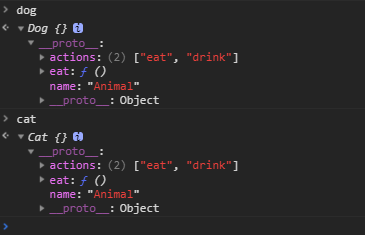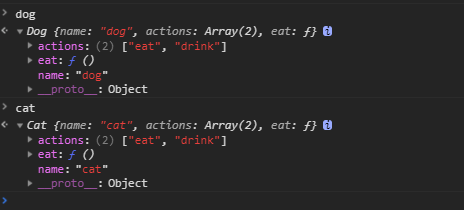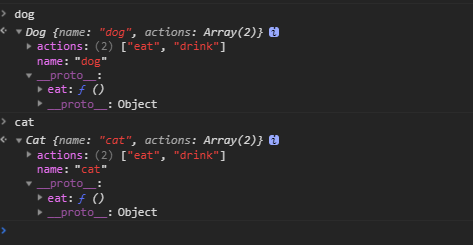ES5与ES6的继承
JavaScript本身是一种神马语言:
提到继承,我们常常会联想到C#、java等面向对象的高级语言(当然还有C++),因为存在类的概念使得这些语言在实际的使用中抽象成为一个对象,即面向对象。JavaScript这门语言本身就是作为浏览器脚本语言的弱语言,伴随着没有类的概念,JavaScript就成为了一种基于对象的语言而不是面向对象的语言,面向对象就会存在继承,那么基于对象的JavaScript是如何继承的。
ES5规则
JavaScript的4种继承方式:
(1)原型继承
栗子:
1 function Animal() { 2 this.name = "Animal"; 3 this.actions = ['eat', 'drink'] 4 this.eat = function () { 5 console.log('eat'); 6 }; 7 } 8 9 Animal.prototype = { 10 age: '6years', 11 hobbies: [] 12 } 13 14 function Dog() { 15 //do someting 16 } 17 Dog.prototype = new Animal(); 18 19 function Cat() { 20 //do someting 21 } 22 Cat.prototype = new Animal(); 23 24 var dog = new Dog(); 25 var cat = new Cat();
结果:

可以看到cat跟dog都继承了animal的实例对象,原型继承原型继承是最基础的继承方式,核心就是重写子类原型,是父类实例对象充当子类原型。
如果此时作如下操作会有什么情况发生
1 dog.name = 'dog' 2 dog.actions.push('look'); 3 dog.age = '7years'; 4 dog.hobbies.push('sleep');
cat的结果:

结果已经很明显了,原型上的引用类型会被共享。
原因就是操作数组时,首先会在对象下找当前数组,如果有就会更改对象下的数组,如果没有就会到原型里面找数组,由于dog跟cat的原型是同一个animal所以修改的就是同一个数组,如果是简单类型,查找对象内没有此属性,重新生成一个属性,并且不会继续使用原型内部的属性,即原型共享。
结论:优点:最基本的继承方式,简单;缺点:原型中的引用类型共享。
到这里是不是有一种原型链的感觉了呢~
(2)改变上下文的继承
1 function Animal(name) { 2 this.name = name; 3 this.actions = ['eat', 'drink'] 4 this.eat = function () { 5 console.log('eat'); 6 }; 7 } 8 9 function Dog() { 10 Animal.call(this, 'dog') 11 } 12 13 function Cat() { 14 Animal.call(this, 'cat') 15 } 16 17 var dog = new Dog(); 18 var cat = new Cat();
结果:

利用call(apply,bind)方式改变了Animal函数内部this的指向,使this指向分别指向了Dog和Cat
优点:摒弃了原型,避免了原型共享;解决了向父类构造函数传参的问题。
缺点:没生成一个新对象,都会重新定义一次function,严重影响内存。
这里是不是有一种多态的感觉了呢~
(3)把前两种结合起来继承:
栗子:
1 function Animal(name) { 2 this.name = name; 3 this.actions = ['eat', 'drink'] 4 } 5 6 Animal.prototype = { 7 eat: function () { 8 console.log('eat'); 9 } 10 } 11 12 function Dog(name) { 13 Animal.call(this, name) 14 } 15 Dog.prototype = new Animal(); 16 17 function Cat(name) { 18 Animal.call(this, name) 19 } 20 Cat.prototype = new Animal(); 21 22 var dog = new Dog('dog'); 23 var cat = new Cat('cat');
结果:

优点:这种方式成功的避免了重复定义function的尴尬情况,同时解决了原型共享的问题。
缺点:如果有两个子类继承父类,但是父类的属性有一个子类不用,怎么搞?这个是没法避免的,而且父类的属性全部在子类的原型上,很不美观。
这里是不是又仿佛看见了new的原理了呢~
(4)寄生组合继承:
为了扣掉组合继承中原型中不需要的属性,看到为了满足这一点,可不可以介样:
1 function Animal(name) { 2 this.name = name; 3 this.actions = ['eat', 'drink'] 4 } 5 6 Animal.prototype = { 7 eat: function () { 8 console.log('eat'); 9 } 10 } 11 12 function Dog(name) { 13 Animal.call(this, name) 14 } 15 Dog.prototype = Animal.prototype; 16 17 function Cat(name) { 18 Animal.call(this, name) 19 } 20 Cat.prototype = Animal.prototype; 21 22 var dog = new Dog('dog'); 23 var cat = new Cat('cat');
结果:

是不是达到了原型中的属性被消灭的效果了呢。这里我们可以联想到什么呢,那就是js的new关键字
回顾一下:
1 var 2 Demo = function () { 3 var 4 self = this; 5 }; 6 7 var demo = {}; 8 demo.__proto__ = Demo.prototype; 9 Demo.call(demo);
区别在于将Demo.prototype是给对象的原型赋值,一个是给方法的原型赋值。
接着上面的栗子来,乍一看好像对,实际Child中的__proto__为Object,并不是Parent,已经背离了Child继承Parent的目的。为啥呢?因为prototype就是Object,js里一切皆为对象。
我们可以自己控制对象的原型
改进:
1 function Animal(name) { 2 this.name = name; 3 this.actions = ['eat', 'drink'] 4 } 5 6 Animal.prototype.eat = function () { 7 console.log('eat'); 8 } 9 10 function Dog(name) { 11 Animal.call(this, name) 12 } 13 14 function Cat(name) { 15 Animal.call(this, name) 16 } 17 18 function initObject(obj) { 19 var 20 F = function () { }; 21 F.prototype = obj; 22 return new F(); 23 } 24 25 var 26 dogPrototype = initObject(Animal.prototype), 27 catPrototype = initObject(Animal.prototype); 28 dogPrototype.constructor = Dog; 29 catPrototype.constructor = Cat; 30 Dog.prototype = dogPrototype; 31 Cat.prototype = catPrototype; 32 var dog = new Dog('dog'); 33 var cat = new Cat('cat');
结果:

可以看到cat与dog的原型已经是Animal了。ES5 over~
ES6规则
1 class Animal { 2 constructor(name) { 3 this.name = name; 4 }; 5 6 eat() { 7 console.log('eat') 8 }; 9 } 10 11 class Dog extends Animal { 12 constructor() { 13 super(); 14 }; 15 16 eat() { 17 super.eat(); 18 }; 19 } 20 var dog = new Dog();
ES6很大程度优化了ES5的继承方式,而且constructor也暴露出来,利用super可以直接调用父级函数以及属性,相当地方便。



 浙公网安备 33010602011771号
浙公网安备 33010602011771号